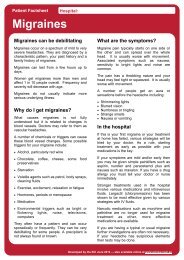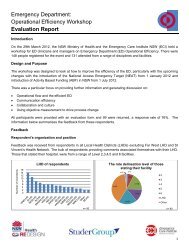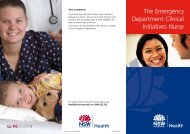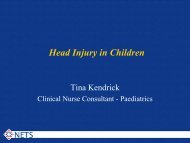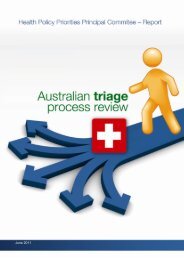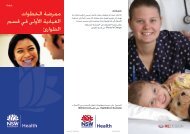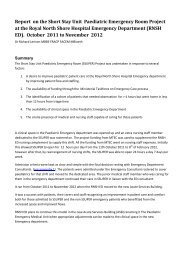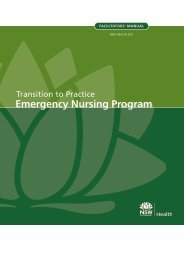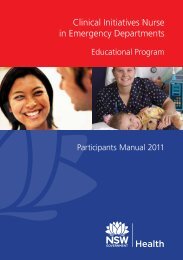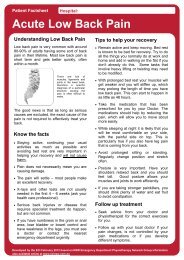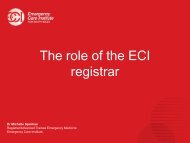Emergency Department Models of Care 2012 - NSW Health
Emergency Department Models of Care 2012 - NSW Health
Emergency Department Models of Care 2012 - NSW Health
- No tags were found...
You also want an ePaper? Increase the reach of your titles
YUMPU automatically turns print PDFs into web optimized ePapers that Google loves.
■■A typical patient suitable for management in a MAU is the undifferentiated complexnon-critical medical patient with co-morbidities. These patients can be streamed from:- The community (i.e. GPs, specialist rooms, ambulatory care or other identifiedcommunity referrals) directly to the MAU through predefined pathways.- ED triage direct to MAU – suitability is determined at ED triage usually by the ED nurseor doctor OR the MAU nurse or doctor.- Within the ED after a very short period <strong>of</strong> time – suitability is usually determined withinthe first hour <strong>of</strong> the ED stay by the ED nurse or doctor OR MAU nurse or doctor.The MAU model <strong>of</strong> care is to provide two streams <strong>of</strong> care:1. For those patients who go home direct from the MAU. Previously, these patientstypically stayed in hospital for 3–5 days. They can now be provided with rapidassessment, faster diagnosis and earlier treatments and sent home safely within 48hours, with community care if needed. This patient group accounts for approximately50% <strong>of</strong> all patients admitted to the MAU.2. For those patients who are transferred to a specialty ward from the MAU. Previously,these patients typically stayed in hospital for 7–9 days. They can now be provided withrapid assessments, faster diagnosis and commencement <strong>of</strong> treatment within the MAU.They are then referred to an inpatient team and transferred to an inpatient ward afterapproximately 24–48 hrs with a documented plan <strong>of</strong> care to be followed. These patientscan be sent home safely within 5–7days. This patient group accounts for approximately50% <strong>of</strong> all patients admitted to the MAU.Why use the model?Key principlesMAUs provide rapid access to an experienced multidisciplinary team at or near to the point<strong>of</strong> entry into a hospital for undifferentiated, complex, chronic, non-critical medical patients.The MAU team aims to provide rapid assessments, faster diagnosis and earlier treatment toenable patients to return to their home environment within 48 hrs or to an inpatient ward iffurther treatment is needed.The MAU Model <strong>of</strong> care provides:■■■■Patients with rapid access to the MAU (Right <strong>Care</strong>, Right Time, Right Place, and RightProvider)Patients in the MAU with rapid assessment, faster diagnosis and earlier treatmentprovided within 48 hoursPatients who require further in-patient care, a continued management plan based ontheir initial rapid assessment, faster diagnosis and earlier treatment.Patients with safe and effective care, and ongoing care or support in their homeenvironment if needed.Benefits <strong>of</strong> the model ■ Reduction in undifferentiated, complex, chronic, non-critical medical patients presentingto the ED by providing direct referral to the MAU■■■■■Reduced length <strong>of</strong> stay in the ED for undifferentiated, complex, chronic, non-criticalmedical patientsDecreased in-hospital Length <strong>of</strong> Stay (LOS) by providing rapid assessment, fasterdiagnosis and earlier treatment at the point <strong>of</strong> entry into a hospitalReduced level <strong>of</strong> intensive investigations prior to decision-makingReduced number <strong>of</strong> patient outliers on inpatient wardsReduction in readmissions due to improved coordination and early activation forcommunity care for those patients discharged home.PAGE 46 <strong>NSW</strong> HEALTH <strong>Models</strong> <strong>of</strong> <strong>Emergency</strong> <strong>Care</strong>




